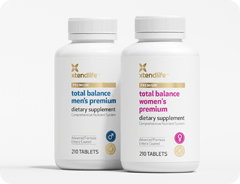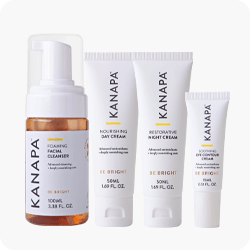We all know that excessive exposure to sunshine and UV rays causes premature skin aging, but what about overexposure to sugar? Did you know that excess sugar causes just as much damage, if not more?
Sugar triggers a process called glycation during digestion. It happens when sugar quickly transforms into blood glucose for energy - and attaches to proteins, forming harmful molecules called Advanced Glycation End products, also rather tellingly known as AGEs. The more sugar we eat, the more AGEs develop.
Proteins, Glycation, and AGEs
Proteins and amino acids serve critical functions in our bodies such as cell repair, transport and storage of nutrients, and supporting organ health. However, they need to be free agents to do their jobs, and when sugar attaches to a protein, this causes the protein to become sticky and bind to other proteins. This in turn affects the functioning of protein in the body.
The proteins that sugar is most attracted to are collagen and elastin - the two protein fibers that keep skin looking firm and elastic, so it bounces back rather than sags.
AGEs not only makes collagen more fragile and less able to keep skin looking good; they also damage the body’s ability to generate antioxidants, leaving skin more vulnerable to further damage. This results in a structural weakness in the skin that leads to wrinkles and fine lines.
Glycation Level and Sugar
Some glycation is normal, of course, but given the amounts of sugar we eat these days - according to Forbes magazine, Americans eat on average 22 teaspoons of sugar per day, almost two and a half times the 9.5 teaspoons per day recommended by the American Heart Association - we are speeding up this aging process without even realizing it!
Refined white sugar and the equally problematic corn syrup are both high in fructose, they are the biggest culprits because they are processed quickly, causing blood sugar levels to spike, resulting in high levels of AGEs.
How to Reduce AGEs
Luckily, foods that are broken down slower by the body such as whole grains and fiber-rich fruits lead to lower blood sugar levels and fewer AGEs.
There is also a compound known as carnosine - a protein building block that is naturally produced in the body - that can neutralize AGEs, acting much in the same way an antioxidant fights a free radical. Essentially, it may slow the aging process, which is why we include L-Carnosine it in our Total Balance Range.
So, keep in mind that we can slow the glycation process and care for skin health by watching what we put into our body first.
How much sugar are you and your family eating each day? Have a close look into your pantry and fridge – let’s face off against this sweet enemy together.
In good health.
Reference:
- http://www.prevention.com/beauty/beauty/how-sugar-ages-your-skin
- http://www.aminoacid-studies.com/amino-acids/what-are-amino-acids.html
- http://www.ncbi.nlm.nih.gov/pubmed/18996880
- http://www.forbes.com/sites/alicegwalton/2012/08/30/how-much-sugar-are-americans-eating-infographic/
- http://www.xtend-life.com/popup/info/Glycation.aspx


 Supplements
Supplements Bundles
Bundles



